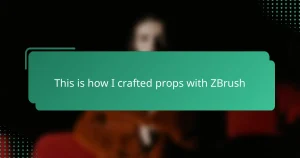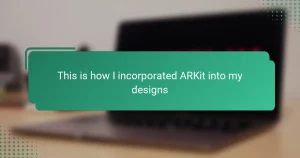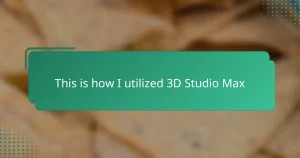Key takeaways
- Science fiction props enhance storytelling by being both visually stunning and functionally believable, requiring attention to detail and creativity.
- Set designers play a crucial role in creating immersive environments that influence prop design, emphasizing collaboration and communication between teams.
- Flexibility and mutual respect in collaborations lead to innovative solutions and richer, more believable science fiction worlds.
- Challenges in prop design often foster creativity and adaptation, pushing designers to align their visions while maintaining functionality.
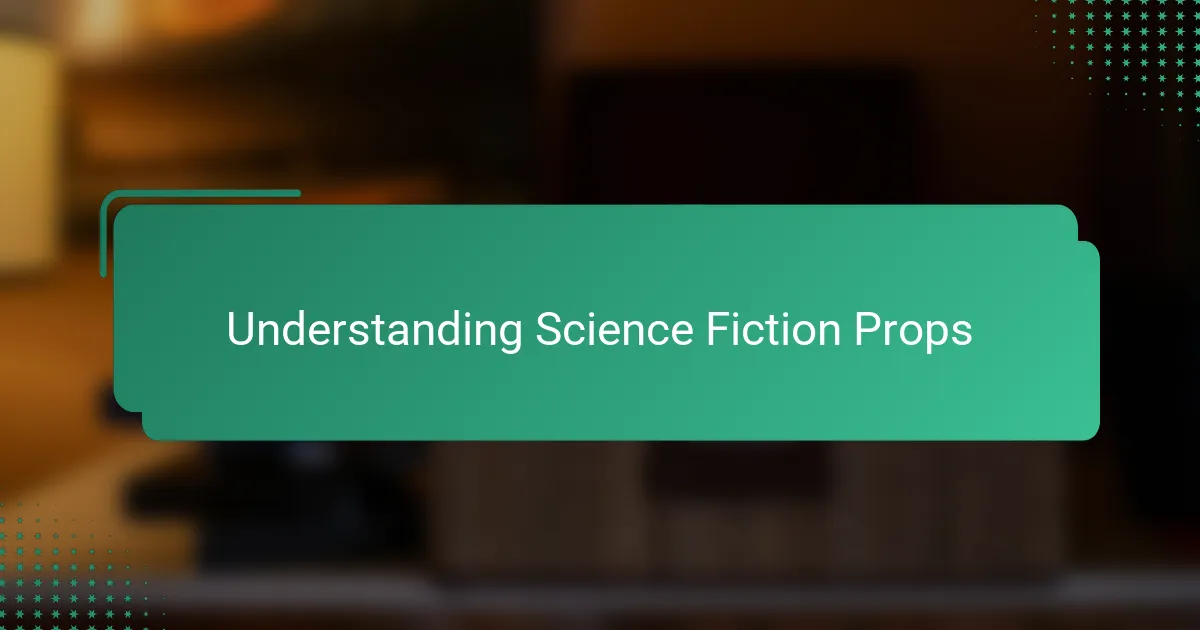
Understanding science fiction props
Science fiction props are more than just objects; they are gateways to immersive worlds. From futuristic gadgets to alien technology, these props need to feel authentic enough to convince the audience that they truly belong in their imagined universe. I’ve often marveled at how a single prop can spark a viewer’s imagination and add depth to the story without a single word being spoken.
Have you ever noticed how some props seem to have a life of their own? That’s because behind every design lies a story, a culture, or an idea waiting to be explored. In my experience, understanding the vision behind each prop helps me appreciate its importance within the larger narrative, making collaboration with set designers even more rewarding.
What makes a science fiction prop successful? To me, it’s the balance between creativity and functionality. A prop can be visually stunning, but if it doesn’t feel practical or believable within the context of its world, it risks losing the audience’s suspension of disbelief. That’s a challenge I always keep in mind when working on designs and selecting props for any project.
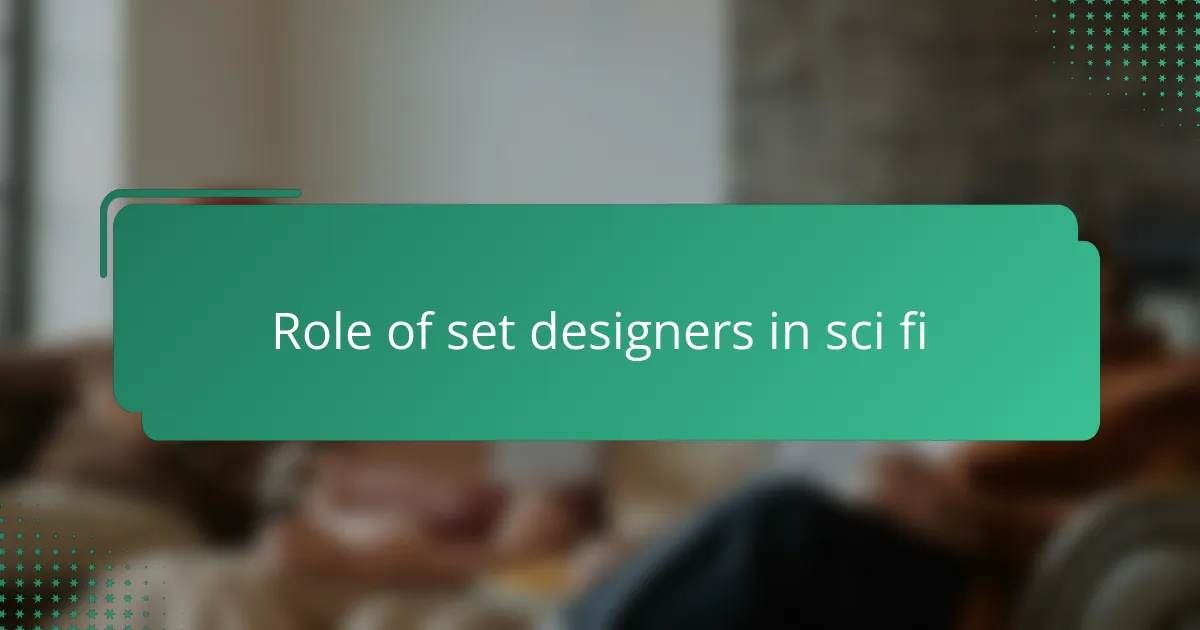
Role of set designers in sci fi
Set designers in sci-fi play a crucial role in shaping not just the environment, but the very essence of the story’s universe. From my experience, their work sets the stage for everything that happens on screen—they create spaces that feel lived-in, believable, and often otherworldly. Have you ever walked onto a sci-fi set and felt instantly transported? That’s the magic of a skilled set designer.
I recall one project where the set designer transformed a simple room into a futuristic lab that felt both ahead of its time and grounded in reality. That attention to detail changed how I approached prop design, making me more mindful of how every element interacts with the space around it. It’s this seamless collaboration that breathes life into science fiction worlds.
Set designers also have the tricky job of balancing imagination with practicality. They must consider how actors move, where cameras will be placed, and how lighting affects the mood—all while maintaining the visual language of an alien or future society. I often think about how their choices influence my work because everything must come together to create a cohesive, believable world that draws the audience in completely.
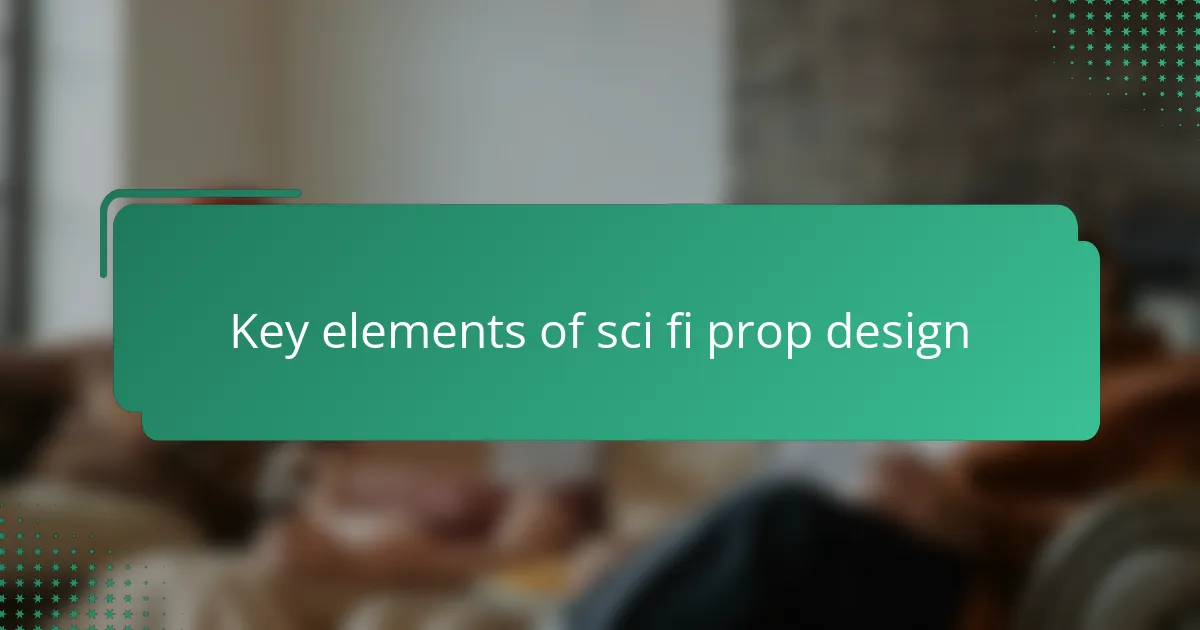
Key elements of sci fi prop design
When I think about the key elements of sci-fi prop design, the first thing that comes to mind is detail. It’s those small, deliberate touches—like aged metal, alien inscriptions, or subtle wear and tear—that convince me a prop has a history. Without that, no matter how futuristic something looks, it risks feeling sterile or lifeless.
Another element that stands out is functionality. I often ask myself, “Could this object actually work within its universe?” It’s not enough for a prop to just look cool; it needs to make sense. For example, if it’s a handheld gadget, it should fit comfortably in an actor’s hand and feel intuitive to use, or else it breaks the immersion.
Lastly, I find that color and texture play a surprisingly emotional role. A prop’s palette can evoke the culture or mood of its world—cold chrome for clinical tech, or rough, organic materials for alien artifacts. When a prop subtly reinforces the story’s tone, it adds a layer of depth that’s hard to achieve any other way. Have you ever noticed how a simple change in surface texture can make you feel totally different about a piece? That’s the magic I love in sci-fi design.
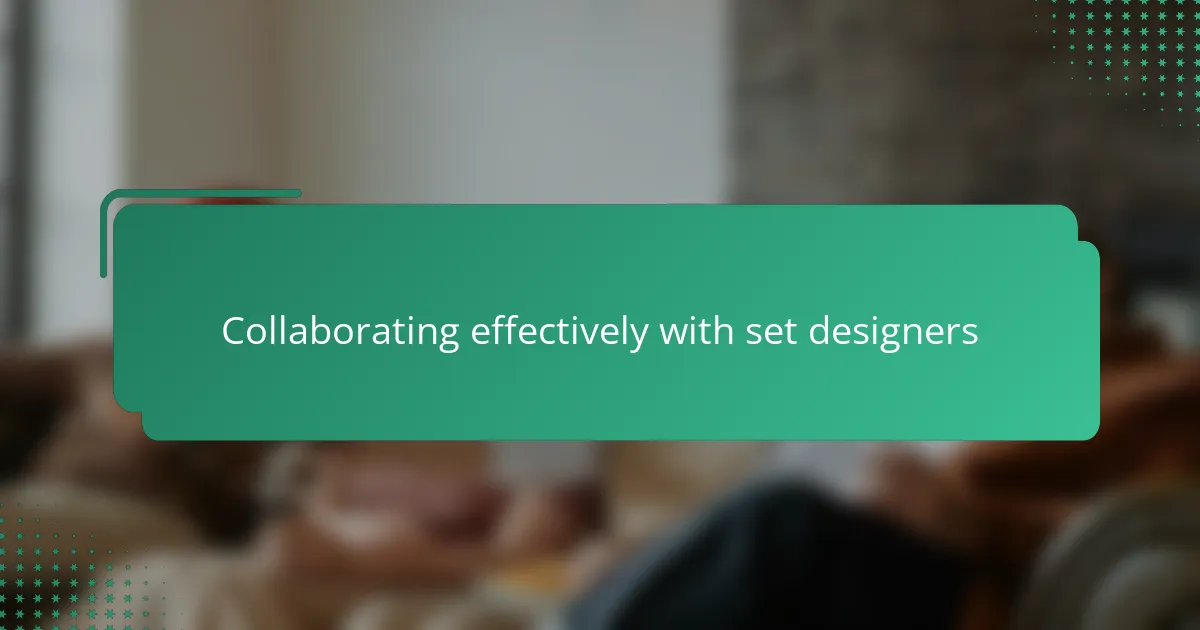
Collaborating effectively with set designers
Effective collaboration with set designers starts with open communication. I’ve found that sharing my ideas early and listening carefully to their vision helps avoid misunderstandings and sparks new creative directions. Have you ever experienced how a simple conversation can transform a prop from good to extraordinary by aligning it perfectly with the set?
Another crucial aspect is flexibility. Sometimes, a set designer’s choices limit what I initially imagined for a prop, but rather than seeing this as a constraint, I see it as an opportunity to innovate. For instance, I once had to redesign a futuristic weapon to better fit a cramped set, and that challenge pushed me to invent a more compact and believable design that ended up being a highlight.
Finally, respecting each other’s expertise builds trust. I always remind myself that while I bring knowledge of materials and mechanics, set designers excel at storytelling through space and atmosphere. When we acknowledge these strengths, the collaboration becomes a dynamic exchange rather than a list of demands, resulting in science fiction worlds that feel truly alive. Have you noticed how that mutual respect often leads to the most memorable creations on screen?
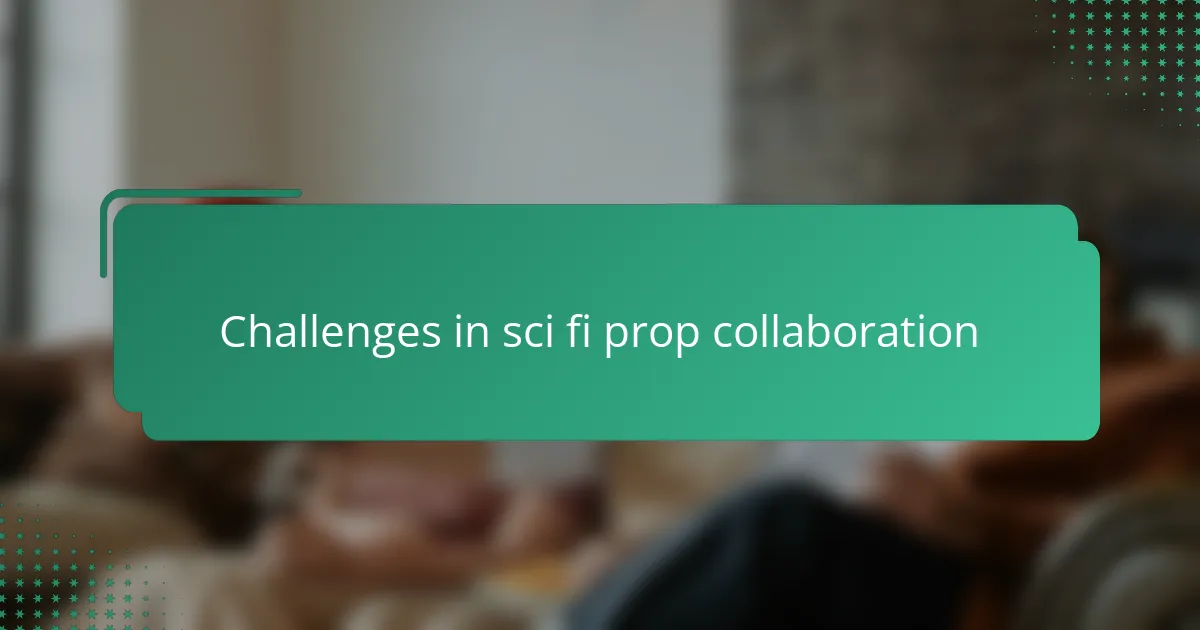
Challenges in sci fi prop collaboration
One challenge I often face when collaborating with set designers is aligning our creative visions. Sometimes, their ideas about the world’s look or atmosphere differ from how I imagine the props fitting in. Have you ever experienced that moment when you realize a prop you designed perfectly might clash with a set’s aesthetic? It can be frustrating, but it pushes me to think more flexibly and adapt my designs without losing their core identity.
Space constraints are another frequent hurdle. I remember working on a project where the set was surprisingly compact, forcing me to rethink the size and mechanics of several props. It’s tricky because I have to maintain the props’ functionality and believability while making them work physically within tight areas. This back-and-forth taught me a lot about the importance of early conversations and prototypes before finalizing designs.
Lastly, balancing futuristic creativity with practical shooting needs can be tough. A prop might look incredible on paper, but if it’s too fragile or cumbersome for actors to handle during scenes, it can cause delays or even get replaced. I’ve learned to anticipate these concerns and consider the set designer’s input on choreography and camera angles early on. Have you noticed how the best collaborations find that sweet spot between imagination and reality? That’s the kind of challenge that really makes the teamwork rewarding.
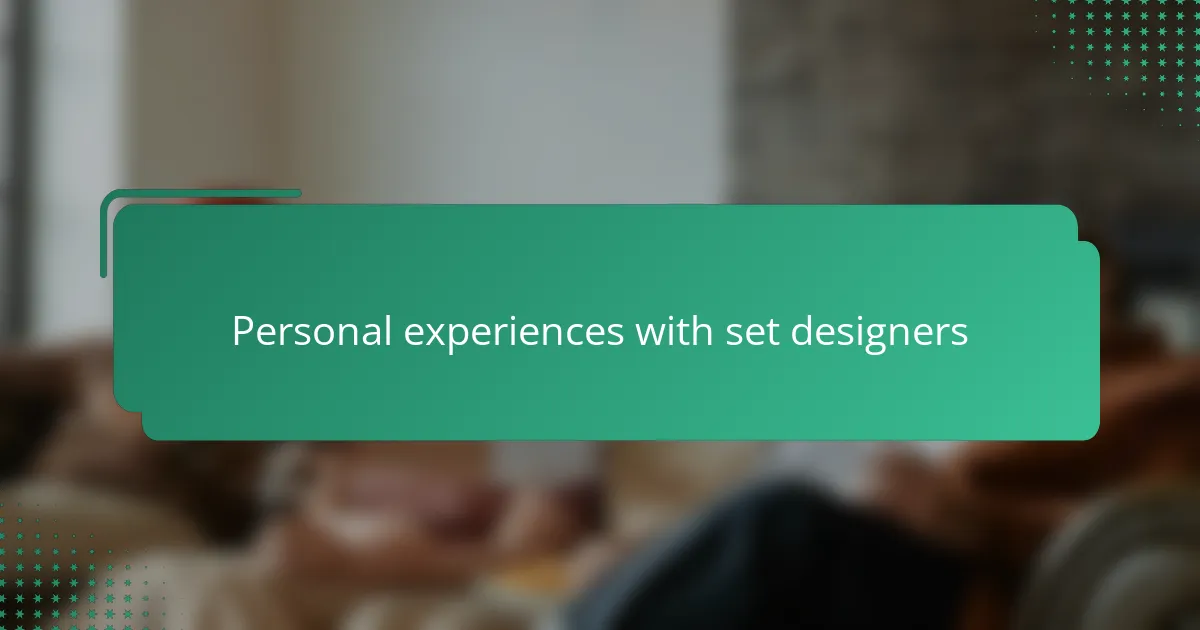
Personal experiences with set designers
Working alongside set designers has taught me that collaboration is as much about listening as creating. I remember one late-night session where we debated endlessly over the placement of a single prop—each suggestion revealing more about their vision and how my designs could complement it. Have you ever found yourself changing your whole approach because a simple conversation opened your eyes to a new perspective? That moment always sticks with me.
There was also a time when a set designer’s bold choice for an alien environment challenged me to rethink my usual design instincts. Initially, I felt a bit frustrated—my go-to techniques weren’t fitting their aesthetic—but that pressure sparked some of my most creative work. Looking back, I realize those challenges deepened my respect for the delicate balance between imagination and practicality on set.
Sometimes, it’s the small, unexpected insights from set designers that resonate most with me. Like when a detail about how an actor moves through a space led me to tweak a prop’s size or texture. Those exchanges remind me that every prop must serve the story and the performers; it’s an intricate dance, and set designers are essential partners in making that dance flow smoothly.

Tips for successful prop partnerships
One tip I’ve found invaluable is to establish clear and frequent communication from the very beginning. Have you ever seen how a quick brainstorming session can reveal unexpected possibilities? Those moments often transform a straightforward prop into something that perfectly harmonizes with the set’s atmosphere, making the entire scene more immersive.
Flexibility is another key ingredient in a successful partnership. I recall a project where a last-minute set adjustment meant my original prop design wouldn’t fit the space. Instead of feeling boxed in, I embraced the challenge, and the redesigned prop ended up looking sleeker and more futuristic than I initially imagined. Sometimes constraints spark the best creativity.
Lastly, I believe mutual respect is the glue that holds such collaborations together. Each team member brings unique expertise—while I focus on functionality and detail, the set designer shapes environment and mood. Recognizing and valuing these perspectives creates a trust that makes problem-solving smoother and leads to richer, more believable science fiction worlds. Have you noticed how respect changes the dynamic from simply working together to truly creating together?
